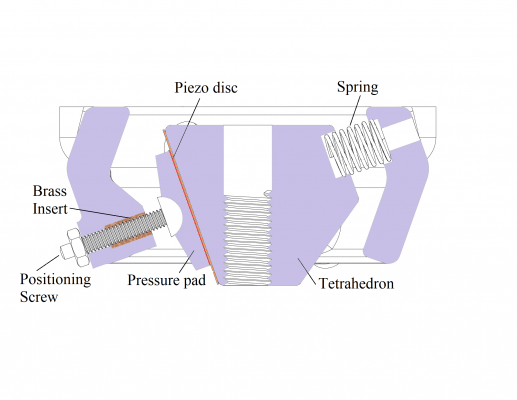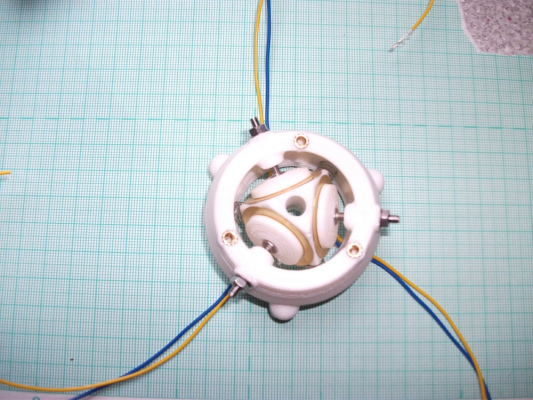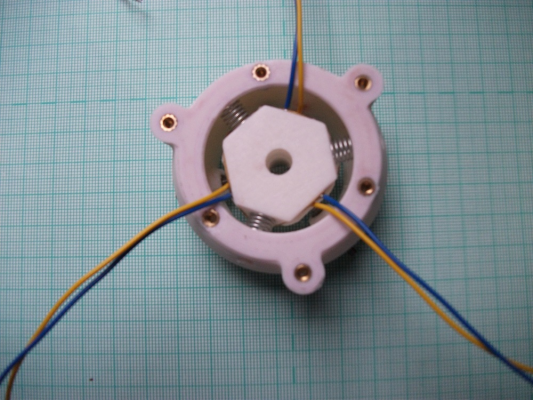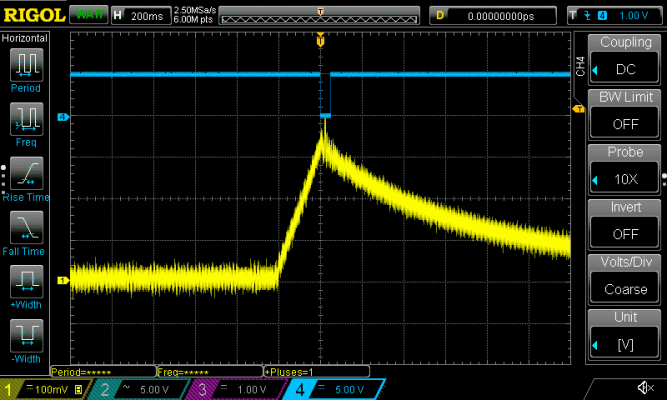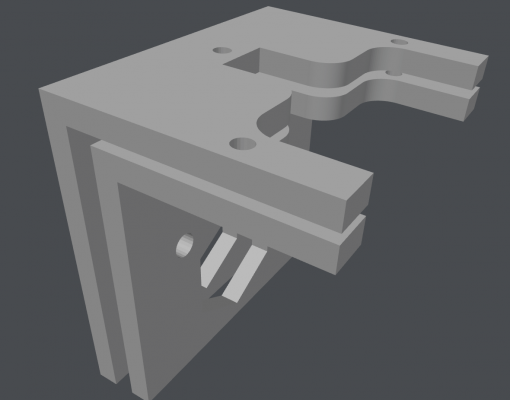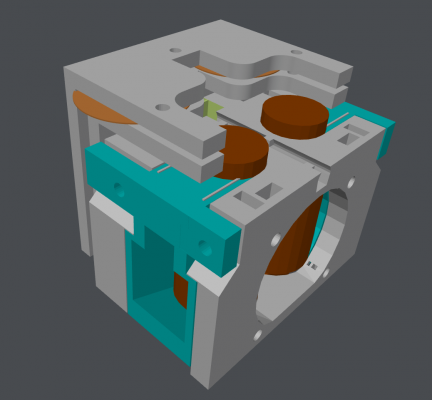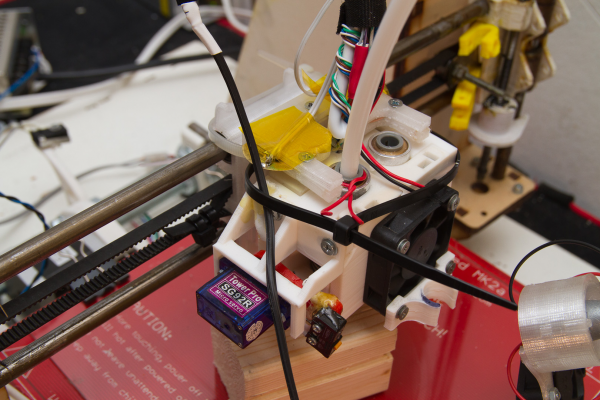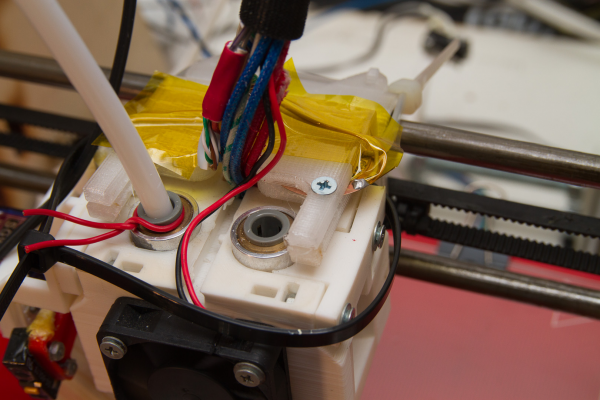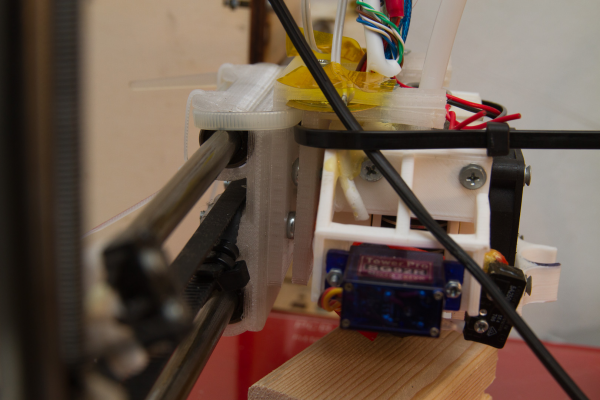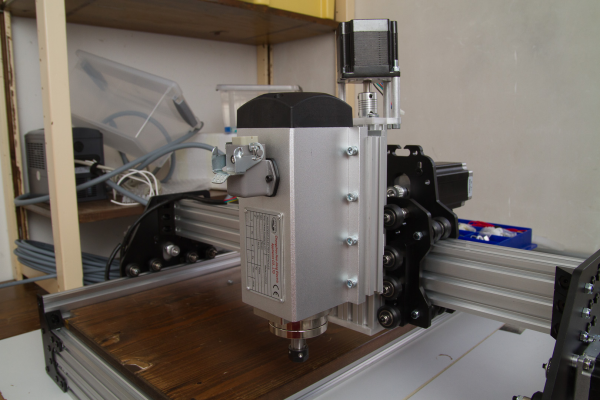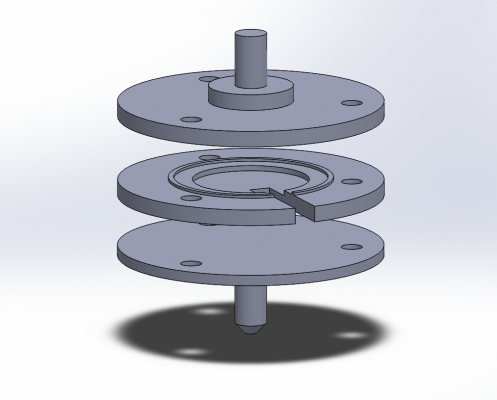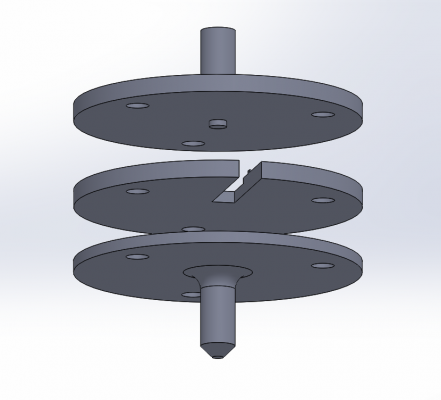|
Re: Piezoelectric disks for Z contact detect and bed levelling June 29, 2017 10:36AM |
Registered: 12 years ago Posts: 1,450 |
Quote
DjDemonD
This is where RRF is now helping us immensely with M558 Rx switch where x is recovery time in seconds before probing dive takes place. 0.2sec seems to take care of this problem. Maybe put in a request with marlin, repetier etc to add this feature. Couple that with z max acceleration at 200mm/min and I'm probing without any other slowdowns /macros.
Ahh! I wondered what recovery time was. I had previously asked on the Repetier forum for a delay between XY movement and Z probing but got no response. I have just asked again using the phrase "recovery time"
Mike
|
Re: Piezoelectric disks for Z contact detect and bed levelling June 29, 2017 10:46AM |
Registered: 9 years ago Posts: 1,873 |
I'd also like to see a configurable safety limit on how far a Z-probe will keep looking for contact. Driving the hotend towards the bed is still quite the leap of faith for me - if the probe ever fails to detect we're in for a world of hurt. I could live with having to manually establish z0 to within 2mm of the bed before probing, and then having a 3mm max probe distance (or something along those lines). There's enough compliance in my build to absorb 1 to 2mm of collision (who am I kidding, it can absorb a lot more at the moment, but I hope to improve on that in my next printer).
|
Re: Piezoelectric disks for Z contact detect and bed levelling June 29, 2017 11:27AM |
Registered: 8 years ago Posts: 3,525 |
Well depending on firmware there are limits, I think with RRF its 5mm default dive height (configurable), so if you can ensure you're within 3-4mm of the bed there's less potential for a head crash. Also setting lower motor current (where applicable to digital driver boards) will also limit head crashes. But it really isn't a big problem, we have around 40-50 units in the wild and no reports of terrible head crashes, probably more false triggers from too much sensitivity instead. I've had a few in testing but then thats to be expected.
My best advice with the standard piezo boards we are currently using is to tap the nozzle upwards with a tool at the start of a printing session, check the LED on the board shows a trigger. Then send G30 and tap with a tool as the nozzle descends, make sure the head moves upwards (or bed downwards). If it passes these tests then you're good to go.
It is possible with current boards (except Piezo20 Modules for important reason I will explain) to set the VR2 pot so the LED just comes on and stays illuminated, then probe - this creates NC operation instead, your firmware needs to expect a falling signal on contact now. If there is a failure then it fails safe like a NC endstop and triggers before nozzle contact. However on Piezo20 boards to get a light-up effect with the transparent modules the triggered LED is quite high powered, and will fail if left on, rather than just lighting up every now and again when triggered, so please DO NOT set Piezo20 modules to NC unless you want your triggered LED to die. We could have used a less bright LED but the module has to work on 3.3v and 5v so when on 5v its drawing just a bit too much current.
Simon Khoury
Co-founder of [www.precisionpiezo.co.uk] Accurate, repeatable, versatile Z-Probes
Published:Inventions
My best advice with the standard piezo boards we are currently using is to tap the nozzle upwards with a tool at the start of a printing session, check the LED on the board shows a trigger. Then send G30 and tap with a tool as the nozzle descends, make sure the head moves upwards (or bed downwards). If it passes these tests then you're good to go.
It is possible with current boards (except Piezo20 Modules for important reason I will explain) to set the VR2 pot so the LED just comes on and stays illuminated, then probe - this creates NC operation instead, your firmware needs to expect a falling signal on contact now. If there is a failure then it fails safe like a NC endstop and triggers before nozzle contact. However on Piezo20 boards to get a light-up effect with the transparent modules the triggered LED is quite high powered, and will fail if left on, rather than just lighting up every now and again when triggered, so please DO NOT set Piezo20 modules to NC unless you want your triggered LED to die. We could have used a less bright LED but the module has to work on 3.3v and 5v so when on 5v its drawing just a bit too much current.
Simon Khoury
Co-founder of [www.precisionpiezo.co.uk] Accurate, repeatable, versatile Z-Probes
Published:Inventions
|
Re: Piezoelectric disks for Z contact detect and bed levelling July 04, 2017 05:56PM |
Registered: 9 years ago Posts: 978 |
|
Re: Piezoelectric disks for Z contact detect and bed levelling July 06, 2017 03:05PM |
Registered: 12 years ago Posts: 1,450 |
YouTube recommended a video showing a Taz auto-leveling upgrade ( [www.youtube.com] ) that had me thinking. The auto-leveling that was shown depended on electrically conductive buttons at the corners of the bed but it strikes me that there is no reason that this couldn't be used to check for nozzle cleanliness. A plan may be a very thin stainless steel shim, 0.05mm thick and say 20mm diameter, epoxied to a corner (at X0, Y0 ?) and used as a contact.
Sequence at the beginning of each print would be:-
This would answer one semi valid criticism or piezo based leveling that deposits on the nozzle would give wrong results
Mike
Edited 1 time(s). Last edit at 07/06/2017 03:05PM by leadinglights.
Sequence at the beginning of each print would be:-
- Heat up build stage and nozzle
- Home all axes.
- Go to nozzle cleaning station and auto clean nozzle
- Go to contact shim and check for continuity.
- Repeat last two up to three times if no contact
- If still no contact sound beeper, alert the boss through OctoPrint or whatever
- Otherwise perform bed leveling (possibly also check that the electrical conductivity check was the right height above the build surface)
- Start print
This would answer one semi valid criticism or piezo based leveling that deposits on the nozzle would give wrong results
Mike
Edited 1 time(s). Last edit at 07/06/2017 03:05PM by leadinglights.
|
Re: Piezoelectric disks for Z contact detect and bed levelling July 06, 2017 03:53PM |
Registered: 7 years ago Posts: 270 |
Quote
leadinglights
YouTube recommended a video showing a Taz auto-leveling upgrade ( [www.youtube.com] ) that had me thinking. The auto-leveling that was shown depended on electrically conductive buttons at the corners of the bed but it strikes me that there is no reason that this couldn't be used to check for nozzle cleanliness. A plan may be a very thin stainless steel shim, 0.05mm thick and say 20mm diameter, epoxied to a corner (at X0, Y0 ?) and used as a contact.
Sequence at the beginning of each print would be:-
- Heat up build stage and nozzle
- Home all axes.
- Go to nozzle cleaning station and auto clean nozzle
- Go to contact shim and check for continuity.
- Repeat last two up to three times if no contact
- If still no contact sound beeper, alert the boss through OctoPrint or whatever
- Otherwise perform bed leveling (possibly also check that the electrical conductivity check was the right height above the build surface)
- Start print
This would answer one semi valid criticism or piezo based leveling that deposits on the nozzle would give wrong results
Mike
While at it you can also verify that piezo sensor is working so there is no need to 'bump' it to verify it's working before each leveling to avoid head crashes.
|
Re: Piezoelectric disks for Z contact detect and bed levelling July 06, 2017 04:49PM |
Registered: 8 years ago Posts: 3,525 |
It's certainly worth trying I could see it being useful on a consumer machine, though it's a but complicated for a reprap. A nozzle cleaning station alone would probably help a lot.
I don't tap my sensor before every probing but we need to advise people to do it until we get NC operation as standard on all the products.
Simon Khoury
Co-founder of [www.precisionpiezo.co.uk] Accurate, repeatable, versatile Z-Probes
Published:Inventions
I don't tap my sensor before every probing but we need to advise people to do it until we get NC operation as standard on all the products.
Simon Khoury
Co-founder of [www.precisionpiezo.co.uk] Accurate, repeatable, versatile Z-Probes
Published:Inventions
|
Re: Piezoelectric disks for Z contact detect and bed levelling July 19, 2017 04:09PM |
Registered: 12 years ago Posts: 1,450 |
In another thread imqqmi wrote about the possibility of using multiple piezo disks to cancel the X and Y components of movement that stop a really precise and light nozzle contact from being registered. This was a thought that I had some time ago but didn't get round to following up - at least until I had some indication that it was not a silly idea: If more than one person has the same idea it may not be all that dumb.
I have made up a proof of concept rig and can confirm that it seems to work, some photos and details below. The basic idea is to fit three piezo elements on three faces of a tetrahedron (a pyramid on a triangular base). Only forces acting in the shared axis would produce an output, anything acting at right angles to the shared axis would cancel out.
The arrangement I settled on is to have the piezos under a spring pre-load so that there would be no sensible movement until the spring pressure was overcome - the forces would still be registered by the piezos which only have to be wired together, the outputs should algebraically sum as long as the polarity is consistent between each piezo. This arrangement has the added advantage that once the spring pre-load had been overcome then the tetrahedron part should lift and this could be used to operate a microswitch to signal that an overload condition exists (i.e., a nozzle crash is occurring, stop the motors and sound the klaxons)
There is a lot still not known - will this enable 1 gram/1 micron detection? Will it work as well as the first tests indicated when other bits are attached Does the cancelling of X and Y directional forces still apply to rotational moments (turning forces.) On top of that, the proof of concept rig is quite bulky as it uses 27mm piezos; 20mm 15mm and even 12mm piezos are available.
Cross sectional drawing showing the position of each piezo element and the spring opposing it. Contact force operates upward
Photo showing the tetrahedron and the piezos
Photo showing the springs
Mike
I have made up a proof of concept rig and can confirm that it seems to work, some photos and details below. The basic idea is to fit three piezo elements on three faces of a tetrahedron (a pyramid on a triangular base). Only forces acting in the shared axis would produce an output, anything acting at right angles to the shared axis would cancel out.
The arrangement I settled on is to have the piezos under a spring pre-load so that there would be no sensible movement until the spring pressure was overcome - the forces would still be registered by the piezos which only have to be wired together, the outputs should algebraically sum as long as the polarity is consistent between each piezo. This arrangement has the added advantage that once the spring pre-load had been overcome then the tetrahedron part should lift and this could be used to operate a microswitch to signal that an overload condition exists (i.e., a nozzle crash is occurring, stop the motors and sound the klaxons)
There is a lot still not known - will this enable 1 gram/1 micron detection? Will it work as well as the first tests indicated when other bits are attached Does the cancelling of X and Y directional forces still apply to rotational moments (turning forces.) On top of that, the proof of concept rig is quite bulky as it uses 27mm piezos; 20mm 15mm and even 12mm piezos are available.
Cross sectional drawing showing the position of each piezo element and the spring opposing it. Contact force operates upward
Photo showing the tetrahedron and the piezos
Photo showing the springs
Mike
|
Re: Piezoelectric disks for Z contact detect and bed levelling July 19, 2017 04:13PM |
Registered: 8 years ago Posts: 3,525 |
That's interesting, very keen to see how that works.
Plus on a perhaps less serious note it looks amazing. That's the sort of thing patents are made of.
Simon Khoury
Co-founder of [www.precisionpiezo.co.uk] Accurate, repeatable, versatile Z-Probes
Published:Inventions
Plus on a perhaps less serious note it looks amazing. That's the sort of thing patents are made of.
Simon Khoury
Co-founder of [www.precisionpiezo.co.uk] Accurate, repeatable, versatile Z-Probes
Published:Inventions
|
Re: Piezoelectric disks for Z contact detect and bed levelling July 19, 2017 04:27PM |
Registered: 9 years ago Posts: 487 |
Looks slick. Is this a strict proof of concept or do you envisage arranging such a beast in a printer? Attached to the hot end or under the bed? (You'd have a wickedly compact effector if you could machine the tetrahedron out of aluminium with water cooling channels then thread a heatbreak and nozzle to the bottom.)
Idris
{Precision Piezo} Accurate, repeatable, versatile z-probe plus piezo discs, endstop cables, pt100, 50w heaters.
Idris
{Precision Piezo} Accurate, repeatable, versatile z-probe plus piezo discs, endstop cables, pt100, 50w heaters.
|
Re: Piezoelectric disks for Z contact detect and bed levelling July 19, 2017 05:01PM |
Registered: 8 years ago Posts: 601 |
Quote
leadinglights
YouTube recommended a video showing a Taz auto-leveling upgrade ( [www.youtube.com] ) that had me thinking. The auto-leveling that was shown depended on electrically conductive buttons at the corners of the bed but it strikes me that there is no reason that this couldn't be used to check for nozzle cleanliness. A plan may be a very thin stainless steel shim, 0.05mm thick and say 20mm diameter, epoxied to a corner (at X0, Y0 ?) and used as a contact.
Sequence at the beginning of each print would be:-
- Heat up build stage and nozzle
- Home all axes.
- Go to nozzle cleaning station and auto clean nozzle
- Go to contact shim and check for continuity.
- Repeat last two up to three times if no contact
- If still no contact sound beeper, alert the boss through OctoPrint or whatever
- Otherwise perform bed leveling (possibly also check that the electrical conductivity check was the right height above the build surface)
- Start print
This would answer one semi valid criticism or piezo based leveling that deposits on the nozzle would give wrong results
Mike
Alternatively --
Set nozzle to 250c
Move to cleaning station
Set nozzle to 120c (or whatever probing temp is)
Nozzles repeatedly moves over cleaning station till new temp is reached.
Even in a fast cooling hot end you should get 3-6 strokes over a cleaning station before you reach the new temperature, or set a minimum for safety. This will remove the need for a contact station. I know there is no certainty that a nozzle will be clean, but I find it *highly* unlikely that it wouldn't be after that routine and the higher heat to begin with will help to remove hardened plastic.
Edited 1 time(s). Last edit at 07/19/2017 07:06PM by Origamib.
|
Re: Piezoelectric disks for Z contact detect and bed levelling July 20, 2017 09:58AM |
Registered: 12 years ago Posts: 1,450 |
Quote
Origamib
....................
Alternatively --
Set nozzle to 250c
Move to cleaning station
Set nozzle to 120c (or whatever probing temp is)
Nozzles repeatedly moves over cleaning station till new temp is reached.
Even in a fast cooling hot end you should get 3-6 strokes over a cleaning station before you reach the new temperature, or set a minimum for safety. This will remove the need for a contact station. I know there is no certainty that a nozzle will be clean, but I find it *highly* unlikely that it wouldn't be after that routine and the higher heat to begin with will help to remove hardened plastic.
What can be left out is often at the heart of good engineering but the contact probe may serve another purpose in that it may detect nozzle contamination which has a high melting point. Combining the electrical contact with a microswitch under the electrical contact may be simple and catch multiple problems before they develop into failed prints.
Mike
|
Re: Piezoelectric disks for Z contact detect and bed levelling July 20, 2017 03:08PM |
Registered: 12 years ago Posts: 1,450 |
Quote
Moriquendi
Looks slick. Is this a strict proof of concept or do you envisage arranging such a beast in a printer? Attached to the hot end or under the bed? (You'd have a wickedly compact effector if you could machine the tetrahedron out of aluminium with water cooling channels then thread a heatbreak and nozzle to the bottom.)
Idris
At the moment it is pure proof of concept but in the next week or so I will have a good idea if it is good for cancelling XY movement artifacts. If it does seem good I will put STLs and possibly STEP files on Thingiverse so anybody who is interested will have something to build on. I have no thoughts of taking it any further at the moment as my bigger projects are getting quite demanding.
Mike
|
Re: Piezoelectric disks for Z contact detect and bed levelling July 24, 2017 05:22AM |
Registered: 12 years ago Posts: 1,450 |
Copying imqqmi's posting from the Precision Piezo Z-probe Now available thread.
That looks really cool - I assume that is a twin nozzle setup
I picked up you idea of using multiple discs to cancel XY noise and put up an earlier post in this thread [forums.reprap.org] Initial indications are very promising and I hope to put an update on this week
A few questions: Is the time base really 200ms/s as shown on scope trace? If so that would imply that there is substantial travel after initial contact although the duration of the PIC output looks to show very quick response to nozzle lift.
The piezo output is very linear but I can't see from the photos whether the piezos are being flexed between the printed parts or if the lower part is being used as a pressure member.
Can you show a screenshot of the noise as it is hard to know if the noise is mechanical or electrical.
I will follow your developments with interest - do you have anything on your CNC machine on a CNC forum?
Mike
Quote
imqqmi on July 23, 2017
Today I've printed a few parts to angle the x-carriage to a top down mount, then in turn back to the back to front mount for the hotend holder. Between these I've placed two piezo disks of 27mm, with one side the brass is cut without cutting the ceramic part. Cutting the disk with scissors is very easy. Just make sure the cutting side of the scissors is on the correct side as that part is getting bent.
This seems to work ok. No drilling is needed this way, and the filament doesn't need to go through the disk either.
Here's a scope plot of the nozzle touching a block of wood placed on the bed. With the prototype parts printed the nozzle couldn't reach the bed anymore but that's ok. I need to redesign it anyway for much better stiffness and rigidity. The blue trace is the PIC16F1827 output (which is now connected to the z endstop connector on the ramps board). the yellow trace is the piezo signal after filtering. I didn't use shielded cables, I'm going to buy some tomorrow to reduce the hum and noise. And if it's build on a pcb it will improve a lot I expect. The comparator threshold voltage is now set to 320mV.
Here are the two mounting plates I've designed to get the z direction forces onto the piezo disks:
The orange circles represent the piezo disks:
Here are the parts printed and mounted. I used kapton tape to secure the wires to the disks since the x axis motion moved the wire and gave big spikes in the signal. Fixing them to the hotend holder solved the problem. I think I'm going to design a part that'll encapsulate the disk including the wires.
I've filtered the output of the disks (in series) using a simple passive 1k and 33nF filter network. This seems to be the sweet spot between signal amplitude and x axis motion immunity. It's immune to velocities up to 133mm/s (8000mm/min). I haven't checked the acceleration, but I've set mine pretty low anyway to prevent ripples in my prints (1200mm/s^2 iirc).
I need to redesign the hot end holder and x carriage to be much more rigid. It's flexing a lot now and is held together with cable ties. I'm also working on building a cnc machine that is capable of machining aluminium. I may be able to make something with that to improve rigidity.
Once redesigned my hotend will be even more compact than before, I could get rid of the servo mount, and I'd be glad to see it goI could even make it so that I don't loose any z height.
I think this is going to work. Too bad it's not going to work for the cnc machine, I don't fancy hanging a 3.5kg spindle off a few piezo disksBut I will think about how I could make this work for that as well. Maybe a separate sensor that can be placed in the collet or attached using neodymium magnets to probe the bed with a known offset if the bed/plate/stock isn't conductive.
The PIC and the handful of other components probably fit on a 20x30mm pcb when everything is done using smd components. It takes 12V, conditioned/smoothed it using ferrite bead and filtering capacitors, 5V is created using a 78L05.
That looks really cool - I assume that is a twin nozzle setup
I picked up you idea of using multiple discs to cancel XY noise and put up an earlier post in this thread [forums.reprap.org] Initial indications are very promising and I hope to put an update on this week
A few questions: Is the time base really 200ms/s as shown on scope trace? If so that would imply that there is substantial travel after initial contact although the duration of the PIC output looks to show very quick response to nozzle lift.
The piezo output is very linear but I can't see from the photos whether the piezos are being flexed between the printed parts or if the lower part is being used as a pressure member.
Can you show a screenshot of the noise as it is hard to know if the noise is mechanical or electrical.
I will follow your developments with interest - do you have anything on your CNC machine on a CNC forum?
Mike
|
Re: Piezoelectric disks for Z contact detect and bed levelling July 24, 2017 06:22AM |
Registered: 9 years ago Posts: 752 |
@leadinglights
Indeed it is a dual extruder setup, though I hardly ever use the second extruder. The alignment is off, the nozzles are hard to align exactly to the bed giving mixed printing results. I have some ideas of rebuilding my own designed 3D printer with lots of rigidity improvements. With the help of the cnc (and its inherently more rigid build which can also be used for a 3D printer) that should hopefully work out ok.
The noise is the same as before the ramping signal, that's just because I use 10x probes and probably due to not properly shielding the wires. The noise is about 100mVtt.
The disks are used as pressure detectors,they're not flexing.
The 3 disk cancellation setup looks very cool! I'm looking forward to advancements in that department. I've found that x vibrations and contact usually are much higher in frequency than touching the nozzle to the bed.
I wonder how it would perform when using a single disk facing the x axis with a weight glued to its surface. The inertia of the x axis should give a voltage. It could be placed anywhere on the x axis removing the need to have a bulky setup. I've read somewhere in Elektor that this is also used to detect earth vibrations.
You're right, there's 200ms before the end stop triggers. This is because the brackets introduce a spring effect which delays the ramping of the piezo disk voltage (that's my guess anyway). Once I've firmed everything up, I expect it should trigger much quicker.
The nozzle lift detection is false though, I just use a delay before pulling the level up again. I'm going to look into the build in hysteresis of the PIC, which is around 65mV.
Another idea I had is to use the lift negative voltage spike when the nozzle lifts off the bed. This could be used as a release trigger. So the piezo disks can then not only trigger on touch events, it can also indicate that the nozzle is still on the bed and moving up/away. This can possibly be secured with a timer that counts say 10 seconds before clearing the condition.
I'm not yet sure how to implement this since it's a negative voltage spike. I could use a couple of 10M ohm resistors as a voltage divider to put the piezo disk at 2.5V, then use thresholds around that voltage, like 2.7V for touch, and 2.3V for release, both with a hysteresis of 65mV. I'm also considering using the ADC as you said earlier, which gives more options to signal conditioning and comparing the signal to an expected curve. The slope of the x axis moving is quite different compared to a z axis bed touch curve.
I could add a 2V reference to the PIC, and with the DAC I could setup the ADC between 2V and 2.816V giving more resolution in the area of interest.
As for the CNC, it's still in the ordering of parts phase, still waiting for the mechanical part to arrive. I hope to get it up and running over the course of a couple of months. I've got an account on cnczone.com but have only posted about a loud stepper motor so far. No build log yet. I may put my buildlog on my own website:
Makercentral
Edited 1 time(s). Last edit at 07/24/2017 06:25AM by imqqmi.
--
Kind regards
Imqqmi
NFAN CoreXY printer:
[reprap.org]
Indeed it is a dual extruder setup, though I hardly ever use the second extruder. The alignment is off, the nozzles are hard to align exactly to the bed giving mixed printing results. I have some ideas of rebuilding my own designed 3D printer with lots of rigidity improvements. With the help of the cnc (and its inherently more rigid build which can also be used for a 3D printer) that should hopefully work out ok.
The noise is the same as before the ramping signal, that's just because I use 10x probes and probably due to not properly shielding the wires. The noise is about 100mVtt.
The disks are used as pressure detectors,they're not flexing.
The 3 disk cancellation setup looks very cool! I'm looking forward to advancements in that department. I've found that x vibrations and contact usually are much higher in frequency than touching the nozzle to the bed.
I wonder how it would perform when using a single disk facing the x axis with a weight glued to its surface. The inertia of the x axis should give a voltage. It could be placed anywhere on the x axis removing the need to have a bulky setup. I've read somewhere in Elektor that this is also used to detect earth vibrations.
You're right, there's 200ms before the end stop triggers. This is because the brackets introduce a spring effect which delays the ramping of the piezo disk voltage (that's my guess anyway). Once I've firmed everything up, I expect it should trigger much quicker.
The nozzle lift detection is false though, I just use a delay before pulling the level up again. I'm going to look into the build in hysteresis of the PIC, which is around 65mV.
Another idea I had is to use the lift negative voltage spike when the nozzle lifts off the bed. This could be used as a release trigger. So the piezo disks can then not only trigger on touch events, it can also indicate that the nozzle is still on the bed and moving up/away. This can possibly be secured with a timer that counts say 10 seconds before clearing the condition.
I'm not yet sure how to implement this since it's a negative voltage spike. I could use a couple of 10M ohm resistors as a voltage divider to put the piezo disk at 2.5V, then use thresholds around that voltage, like 2.7V for touch, and 2.3V for release, both with a hysteresis of 65mV. I'm also considering using the ADC as you said earlier, which gives more options to signal conditioning and comparing the signal to an expected curve. The slope of the x axis moving is quite different compared to a z axis bed touch curve.
I could add a 2V reference to the PIC, and with the DAC I could setup the ADC between 2V and 2.816V giving more resolution in the area of interest.
As for the CNC, it's still in the ordering of parts phase, still waiting for the mechanical part to arrive. I hope to get it up and running over the course of a couple of months. I've got an account on cnczone.com but have only posted about a loud stepper motor so far. No build log yet. I may put my buildlog on my own website:
Makercentral
Edited 1 time(s). Last edit at 07/24/2017 06:25AM by imqqmi.
--
Kind regards
Imqqmi
NFAN CoreXY printer:
[reprap.org]
|
Re: Piezoelectric disks for Z contact detect and bed levelling July 24, 2017 08:11AM |
Registered: 12 years ago Posts: 1,450 |
Just a quick update on the 3 piezo sensor proof of concept trials.
The first problem has shown itself. When the tetrahedron is lifted clear of the piezos and then returned it does not necessarily return to where it started. On the rig there is a "circle of confusion" which would mean the nozzle settling anywhere up to 2mm from where it started - pretty much as non-ideal as you can get. First attempts to correct this will involve using a PTFE sliding contact instead of the pressure pad, possibly with a PTFE sheet over the piezo as well. It also looks as if replacing the three springs with a single one will also be better at getting back to the starting position. A further improvement may be got by reducing the height of the tetrahedron - flattening it out a little. Since the tetrahedron lifting is an exception condition and shows a nozzle collision I think a circle of confusion better than 0.25mm will be O.K.
I am still building a rig to shake it about in X, Y and Z planes but simple "bang it on the desk" type tests look good - this may be a lucky first shot though so will need some firm numbers and multiple tests.
The first problem has shown itself. When the tetrahedron is lifted clear of the piezos and then returned it does not necessarily return to where it started. On the rig there is a "circle of confusion" which would mean the nozzle settling anywhere up to 2mm from where it started - pretty much as non-ideal as you can get. First attempts to correct this will involve using a PTFE sliding contact instead of the pressure pad, possibly with a PTFE sheet over the piezo as well. It also looks as if replacing the three springs with a single one will also be better at getting back to the starting position. A further improvement may be got by reducing the height of the tetrahedron - flattening it out a little. Since the tetrahedron lifting is an exception condition and shows a nozzle collision I think a circle of confusion better than 0.25mm will be O.K.
I am still building a rig to shake it about in X, Y and Z planes but simple "bang it on the desk" type tests look good - this may be a lucky first shot though so will need some firm numbers and multiple tests.
|
Re: Piezoelectric disks for Z contact detect and bed levelling July 29, 2017 09:10PM |
Registered: 7 years ago Posts: 232 |
[arduino-elektronika.eu]Quote
dart16
Another piezo sensor board...looks like some level clamping diodes followed by a comparator giving an analogue output that can be adjusted for sensitivity... At £1.68 each I ordered two to find out
Piezo vibration sensor
this module seem to be good too
so it could be the best cheapest and accurate bed leveling
or this
[www.gearbest.com]
Edited 1 time(s). Last edit at 07/29/2017 09:19PM by titeuf007.
|
Re: Piezoelectric disks for Z contact detect and bed levelling July 29, 2017 09:50PM |
Registered: 7 years ago Posts: 232 |
Quote
DjDemonD
This is where RRF is now helping us immensely with M558 Rx switch where x is recovery time in seconds before probing dive takes place. 0.2sec seems to take care of this problem. Maybe put in a request with marlin, repetier etc to add this feature. Couple that with z max acceleration at 200mm/min and I'm probing without any other slowdowns /macros.
on smothieware i think we have this features
|
Re: Piezoelectric disks for Z contact detect and bed levelling July 30, 2017 02:45AM |
Registered: 8 years ago Posts: 3,525 |
You do but only on the latest edge build as I requested it and it got included.
Simon Khoury
Co-founder of [www.precisionpiezo.co.uk] Accurate, repeatable, versatile Z-Probes
Published:Inventions
Simon Khoury
Co-founder of [www.precisionpiezo.co.uk] Accurate, repeatable, versatile Z-Probes
Published:Inventions
|
Re: Piezoelectric disks for Z contact detect and bed levelling July 30, 2017 04:34AM |
Registered: 7 years ago Posts: 232 |
[github.com]
you speak about this version? with this
[github.com]
i really love this projet and the new dc42 effector project with pcb
great job dude
you speak about this version? with this
[github.com]
i really love this projet and the new dc42 effector project with pcb
great job dude
|
Re: Piezoelectric disks for Z contact detect and bed levelling July 30, 2017 07:14AM |
Registered: 8 years ago Posts: 3,525 |
Yeah the latest one should have the PR requesting a pause before probing, look back through the thread [forums.reprap.org] you'll find the bit about firmware modifications, its around page 7-9 I think.
Thanks, its a step forwards.
Simon Khoury
Co-founder of [www.precisionpiezo.co.uk] Accurate, repeatable, versatile Z-Probes
Published:Inventions
Thanks, its a step forwards.
Simon Khoury
Co-founder of [www.precisionpiezo.co.uk] Accurate, repeatable, versatile Z-Probes
Published:Inventions
|
Re: Piezoelectric disks for Z contact detect and bed levelling July 30, 2017 10:04AM |
Registered: 7 years ago Posts: 232 |
|
Re: Piezoelectric disks for Z contact detect and bed levelling July 30, 2017 12:49PM |
Registered: 8 years ago Posts: 3,525 |
Thanks, waiting on some PCBs but should be back in stock early next week.
Simon Khoury
Co-founder of [www.precisionpiezo.co.uk] Accurate, repeatable, versatile Z-Probes
Published:Inventions
Simon Khoury
Co-founder of [www.precisionpiezo.co.uk] Accurate, repeatable, versatile Z-Probes
Published:Inventions
|
Re: Piezoelectric disks for Z contact detect and bed levelling July 31, 2017 06:47PM |
Registered: 9 years ago Posts: 752 |
I believe the Marlin firmware also has a pause before plunging build in. I use it to wait for the servo motor to stop wiggling before plunging down. I'm not sure if you have to activate the servo probe code part to use this though but I guess if you don't have a servo connected, this shouldn't be a problem to enable.
My CNC kit has arrived and am in the process of building it. I've documented the process but didn't post about it just yet.
Here's a teaser image of the cnc router, I just managed to mount the 3.5kg 1.5kW spindle:
--
Kind regards
Imqqmi
NFAN CoreXY printer:
[reprap.org]
My CNC kit has arrived and am in the process of building it. I've documented the process but didn't post about it just yet.
Here's a teaser image of the cnc router, I just managed to mount the 3.5kg 1.5kW spindle:
--
Kind regards
Imqqmi
NFAN CoreXY printer:
[reprap.org]
|
Re: Piezoelectric disks for Z contact detect and bed levelling August 05, 2017 11:10AM |
Registered: 8 years ago Posts: 916 |
I've just gotten around to drilling out a piezo, soldering some pads on, and connecting it up to my board.
(Yes it's taken a while )
)
How would you recommend I modify this:
[www.thingiverse.com]
to mount the piezo so as to trigger reliably?
btw I'm very impressed with the sensitivity of this thing, just a light finger tap on the piezo makes the signal light flash. That's really impressive
(Yes it's taken a while
 )
)How would you recommend I modify this:
[www.thingiverse.com]
to mount the piezo so as to trigger reliably?
btw I'm very impressed with the sensitivity of this thing, just a light finger tap on the piezo makes the signal light flash. That's really impressive

|
Re: Piezoelectric disks for Z contact detect and bed levelling August 05, 2017 11:39AM |
Registered: 12 years ago Posts: 1,450 |
Hmmm!! that is a bit of a quandary. My first thought is to go for underbed but some dragons may lurk to jump on the unwary there - at least two intrepid adventurers are exploring the terrain there at the moment. Second though is to use a much larger piezo - (35 or 41mm) with a big hole through which the Bowden clamp can run. Start the hole with a small drill bit and open with a dremel - DO NOT breath in the powder!!! bade the clamp on DjDemonD's design.
Mike
Mike
|
Re: Piezoelectric disks for Z contact detect and bed levelling August 05, 2017 06:15PM |
Registered: 9 years ago Posts: 752 |
I've designed a probe for my cnc. I've just completed the build and I'm in the process of testing/tramming it now.
I need to print and test this design, but I think it should work. There's 3 parts to be 3D printed, the top part which should fit into the ER11 collet nut (6mm shaft), with a small pointy area to go against the center of the piezo to flex it (on the brass side). The middle part has a pocket where the piezo element should go. The ridge is to protect it from over tightening it. I don't know how much flex it can take before breaking though. I've set it up for about 0.5mm of depth.
The bottom part is the actual probe that will probe the spoiler board or work piece. I'm planning to solder a 35um copper foil strips to the piezo so that it's a lot more compact than can be done with wires. I'll make a sandwich with kapton tape and make soldering points for the wire on the outside of the probe. All three parts can be clamped down with M3 screws and nuts. This design is for a 27mm outer diameter piezo with an inner 20mm ceramic disk. I've also found some 20mm piezo elements, I'll try those too to see if the sensitivity isn't too bad, it can make the design a little less bulky.
--
Kind regards
Imqqmi
NFAN CoreXY printer:
[reprap.org]
I need to print and test this design, but I think it should work. There's 3 parts to be 3D printed, the top part which should fit into the ER11 collet nut (6mm shaft), with a small pointy area to go against the center of the piezo to flex it (on the brass side). The middle part has a pocket where the piezo element should go. The ridge is to protect it from over tightening it. I don't know how much flex it can take before breaking though. I've set it up for about 0.5mm of depth.
The bottom part is the actual probe that will probe the spoiler board or work piece. I'm planning to solder a 35um copper foil strips to the piezo so that it's a lot more compact than can be done with wires. I'll make a sandwich with kapton tape and make soldering points for the wire on the outside of the probe. All three parts can be clamped down with M3 screws and nuts. This design is for a 27mm outer diameter piezo with an inner 20mm ceramic disk. I've also found some 20mm piezo elements, I'll try those too to see if the sensitivity isn't too bad, it can make the design a little less bulky.
--
Kind regards
Imqqmi
NFAN CoreXY printer:
[reprap.org]
|
Re: Piezoelectric disks for Z contact detect and bed levelling August 06, 2017 03:22PM |
Registered: 12 years ago Posts: 1,450 |
|
Re: Piezoelectric disks for Z contact detect and bed levelling August 06, 2017 03:25PM |
Registered: 8 years ago Posts: 3,525 |
Quote
nebbian
I've just gotten around to drilling out a piezo, soldering some pads on, and connecting it up to my board.
(Yes it's taken a while)
How would you recommend I modify this:
[www.thingiverse.com]
to mount the piezo so as to trigger reliably?
btw I'm very impressed with the sensitivity of this thing, just a light finger tap on the piezo makes the signal light flash. That's really impressive
Glad you gave it a whirl. I do wonder whether under bed might be the way forward. That's a well honed effector setup and I can't see an easy piezo install in it. But I am sure you'll come up with something.
When you do let me know, as I am thinking about how to fit a piezo sensor into an i3 Mk2 which is not dissimilar in that it has an enclosed e3d hotend.
Edited 1 time(s). Last edit at 08/06/2017 03:41PM by DjDemonD.
Simon Khoury
Co-founder of [www.precisionpiezo.co.uk] Accurate, repeatable, versatile Z-Probes
Published:Inventions
|
Re: Piezoelectric disks for Z contact detect and bed levelling August 06, 2017 07:10PM |
Registered: 10 years ago Posts: 293 |
DjDemonD, I just got my pre-assembled Piezo20 in the mail (looks good) however it looks like the side mounted board control board will not fit within the triangular columns of the 713Maker setup for my Rostock V3. Can the piezo sensor wires be extended a bit without causing problems? I'm only thinking an inch or two so that I can move the board up near the Bowden fitting instead.
Sorry, only registered users may post in this forum.
